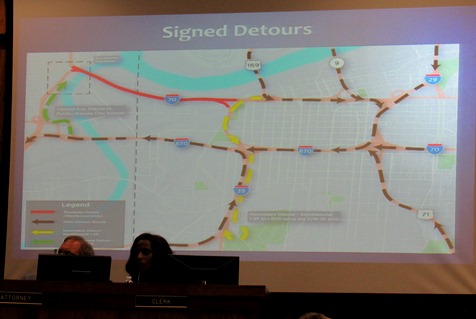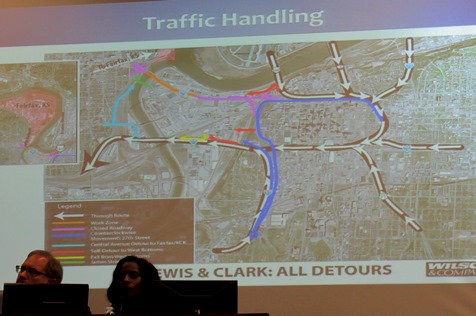
by Mary Rupert
Mayor Mark Holland on Thursday night asked the Kansas Department of Transportation to delay the Lewis and Clark West Viaduct bridge reconstruction project for at least a year.
The mayor said at the Unified Government Commission meeting Thursday that he was concerned about the timeline on the project.
The Mid-America Regional Council is currently planning work on the Buck O’Neil Bridge-Broadway Bridge and the north loop of I-70 in Kansas City, Mo., he said. That is a good reason to postpone the Lewis and Clark viaduct project for a year so that these projects could be integrated fully, he said.
“I-70 was built to go around KCK, not to KCK,” he said, “so we lost huge chunks of our city.”
Currently, other cities are taking down these sorts of highways in order to gain access to riverfront development, he said. There is a vision in Kansas City, Mo., and with MARC to recapture the riverfront, particularly in the east bottoms, he added.
He believes MARC is trying to gain a vision of riverfront access with its study. “I think the best real estate in KCK is looking out over our river, and it’s completely inaccessible to the people,” Holland said.
He said he was concerned about spending a lot of money on this plan, which is yesterday’s plan for transportation.
“I want a viaduct that has light rail on it, that’s going to connect us to Kansas City, Mo., in a more organic way,” Holland said. He favors a plan that would be multi-modal and development-focused in its vision.
“I just think the plan is 30 years ago. I don’t think it’s the best plan for the riverfront, for linking the two cities. It might be the best plan for moving the maximum number of cars through Kansas City at high speeds. That’s not my goal. I don’t want to move people through, I want to move people to Kansas City, Kansas,” Holland said.
He favors Fairfax access to the interstate, he added.

Property values on the east side of Kansas City, Kansas, are almost all lost today because of a terrible vision made about I-70 around 50 or 60 years ago, he said.
The mayor said he didn’t want to lose the money for this project, with this phase estimated at $60 million, and the project should wait until MARC is done with its study.
Holland said he had asked the governor and KDOT to wait for a year and to look at the MARC study, which may include plans for riverfront development.
“I don’t want for Kansas City, Mo., to come up with a great transportation plan and for Kansas City, Kansas, to be left out of it because the timing of our projects didn’t match up,” Holland said.
The mayor also said this viaduct project had been delayed a few years already because of lack of funds at the state level.
Nicole Randall, spokeswoman for KDOT, said she was not authorized to give an answer on it Thursday, but she would take the concerns to the secretary of transportation and the governor’s office.
“The project is happening because there are issues that have been found with that bridge, and it is pertinent to replace it,” she said.
“We believe this is the best course of action,” she said.
Kim Curry, of Burns and McDonnell, who is working with the project, told the UG Commission earlier in the meeting that an ad for bids on the bridge project is scheduled to go out Tuesday, and that bid-letting is scheduled in mid-November. The westbound bridge would be closed in February 2018 for two years, she said.
She gave a presentation about the bridge project, and said many meetings had been held with residents, groups and local governments here.
While Mayor Holland said he didn’t think the bridge was in danger of falling down, and this was just a timing issue, Curry said for each year the project is delayed KDOT has to keep up with the maintenance, and the costs keep increasing.
Leroy Koehn, a KDOT engineer, said there were problems with the bridge’s joints right now. If it isn’t shut down, they would have to do some work on the bridge joints, which would affect traffic, he said. He said it was exciting to work in different forms of transit with the project, and perhaps the transit elements could be added later to the eastbound viaduct project.
The total cost of the viaduct project including its different phases could be $250 million to $300 million, according to officials.

Commissioner Jane Philbrook, 8th District, said it seems like a big mismatch in timing on these projects. She said since the federal government wants to have a regional approach to planning, she suggested the state of Kansas come into compliance with that attitude.
“I would like to see us working cohesively to create something good for this whole community, and not just zoom past us, like it has been set up,” Philbrook said.
Commissioner Gayle Townsend, 1st District, asked about the westbound I-70 route to Fairfax. Curry said while the bridge is being constructed, motorists would get onto I-670, get off at Central Avenue, merge onto eastbound I-70, then go on 3rd Street and access the Fairfax ramp. Anyone coming from the north may want to consider coming in from the Fairfax bridge, she said.
When the westbound Lewis and Clark viaduct bridge is completed in two years, there will be connections to Minnesota Avenue, Washington Boulevard and Fairfax Trafficway, according to KDOT officials.
Commissioner Melissa Bynum, 1st district at large, said her concerns were mostly with Fairfax. She said she was hoping KDOT would work with the Fairfax Industrial Association, and all businesses there, and install signs that promote moving traffic.
Commissioner Philbrook said the Central Avenue exit may be fun with a Mini Cooper, but not an 18-wheeler.
“It’s a skinny exit, and it’s not banked very well, so I’m afraid to see how many 18-wheelers are going to end up halfway hanging over the end of that,” Philbrook said.
Curry said businesses should find a route that gives them a predictable travel time. There are other routes that residents may take that will not be an official detour, she said. Another project official said once the traffic control is set up when the project starts, it will be the same way for two years and will not change. Once people get used to it, it will be the same way for two years, he said.
“You’re letting them have the damage and the problems, to figure it out eventually,” Philbrook said. “It seems pretty cavalier to me.”
Commissioner Brian McKiernan asked if signage would be improved on I-70 during the construction. He was concerned about rerouted traffic and last-minute lane changing in Kansas City, Mo. An engineer said there will be modified signs.
The presentations went into detail about how the exits in the downtown area of Kansas City, Kansas, would be affected by the projects. To see more of the details, the UG meeting is online at https://www.youtube.com/watch?v=y87YMHtaULI.



